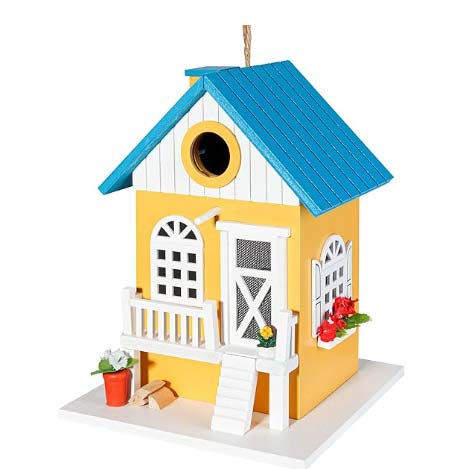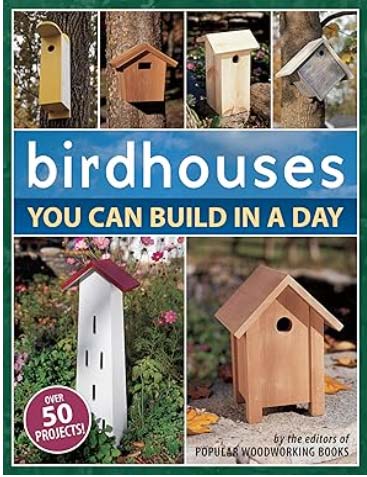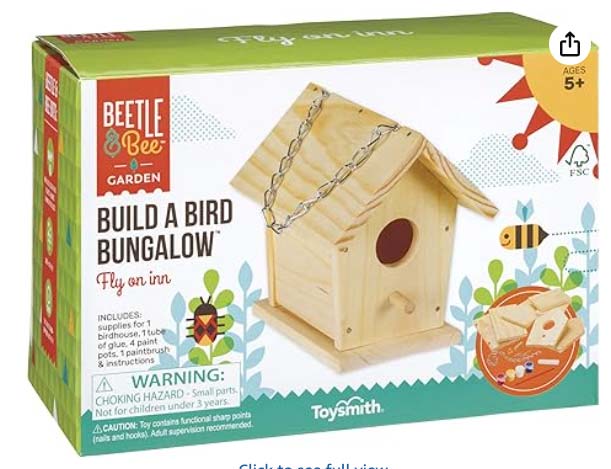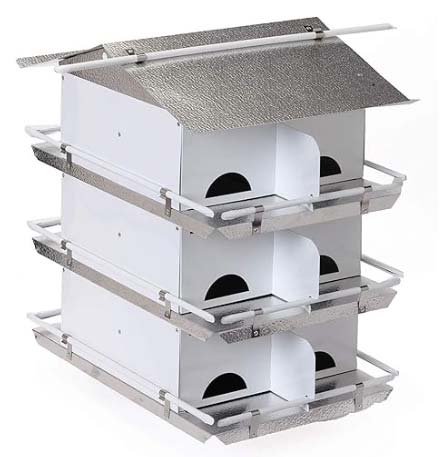This blog is about house inspection but in the process, it is fun to take a break and consider something creative but related in the broader scheme of things (to houses and house inspection, sort of), isn’t it?
This will give you a break from thinking about YOUR house in a sense that may make you want to scream and run from the room. Instead, you can calm your mind and allow it to relax as you focus on something, something creative, something that benefits the overall experience of living in your house (and backyard).
I like to think of birds as friendly little neighbors who are ok with cohabitating with you in your backyard and happy to share their beauty with you while cohabitating. Granted, they also share their poop, too, but don’t we all? The only difference is that we have grown high enough on our bloom’s taxonomy level of analysis and understanding to decide where we will excrete those things and hopefully are choosing not to do it in the backyard. Then, again, maybe it is the birds who have grown in intelligence (and emotional intelligence! – like, when was the last time a bird was insulting another bird on Facebook?!). Of course, that is why there are garden hoses, to take care of those little contributions which we do not desire to have. Now, enough about poop and on to the birdhouses or the birds, at the least…
There are some who will say that the birds are the add-ons in your backyard. I guess there is a little too much California in me because I prefer to take the cohabitating view than to think of them as some sort of object. But, enough on philosophy or political views… Hey, those all start with p… poop, philosophy, politics… Yes, I am in a weird mood 🙂
There are several reasons why you may want to build a birdhouse (or why the birds may want you to build a house for them).
If you think of birds as your entertainment, even in a nice way, it may be that you want to fascinate or attract them so that you can watch them. Personally, I am not one who wants to be lured into some giant’s backyard to be watched. But, then again, if I were hungry enough and I could receive free room and board in my own house and could keep my clothes on then maybe it isn’t a bad idea (trying to look at it from the bird’s point of view).
That said, for some birds (and no, I may be almost done and be a psychologist, but I am not a bird psychologist) the birdhouse is appealing to them. That doesn’t mean that all birds want (or are even interested in) a birdhouse. Keep in mind that you may go to all this work to build a birdhouse and your little feathered friend is not in the least bit interested. That is part of the reason why we are attempting to keep it simple. Let’s exert as little energy as possible, not because we are lazy or do not care but because it is possible we will exert the energy and the bird will not be interested. Don’t blame the bird. Don’t blame yourself. Just realize that it is a risk we all take.
Of course, sometimes we have birds who want to hang out in the backyard because we picked the right bird food that appeals to them or they have decided they like the trees in our yard better than the Johnson’s backyard. Hey, life happens. Accept it and don’t lose sleep over it, okay? 🙂
If you want to even the odds a bit, maybe Google the type of bird you think may be eyeing your backyard and see what type of habitat your friend tends to like and look to providing the materials (and food!) that your bird friend may like.
It might seem like these are minor things or minor measurements, etc., research (and practice) has demonstrated that while you cannot necessarily predict exactly what the birds will do (or want), there are basics that are essential to their comfort and their needs in their living space. Of course, they know best but it isn’t like they are going to perch on your back porch and give you the blueprints for their dream birdhouse. So, we rely on what has work for others (hence, the research and others’ practice) and a little bit of trial and error and hope that it works. Then, we sit back and see if our bird friends like what we have made for them.
- Do your homework. Identify what species of bird it is that you are targetting. Remember, these are your friends. You are not on a hunt. But,
since they do not likely speak English, you need to identify what species of bird they are so that you can do your homework to determine what type of house they want. Also, research whether this type of species is a burrow dweller or a cavity dweller. Try a Google search to do some research on the types (and species). BTW some cavity dwellers (birdhouse dwellers) include Chickadees, Wrens, Flickers, and Bluebirds.
- Think in terms of the birdhouse design. Now that you have identified the species and type, think in terms of the type of birdhouse you would like to build. It is easier once you have completed the first step (homework) and even when you can find pictures online, to help you with that visualization process.
- One at a time…to start. Birds can be territorial, so start with the one birdhouse for now.
- Write down the dimensions. Calculate the dimensions you need (again, Google helps in finding what birds need what dimensions). You will need dimensions for the entrance hole, floor size, depth, and height. As an example, small birds (Chickadees and Wrens) like eight inches in depth and they tend to like 4×4 floor sizes.
- And, many more, but we have broken those down into sections for you…We invite you to continue to read 😉
Do you need some help in reaching your goals for home-cooked meals? Check out the once-a-month meal-planning for 30 days that is done for you! (This is an affiliate link, but love it because it helps me with my once-a-month cooking.)
The Right Attitude for Birdhouse Design
We covered some of these already but just going to reiterate some basics, ok?
Like we said, above, some people build the houses for themselves so that they can sort of capture the birds as their entertainment. I don’t personally buy into all that but neither can I tell you what to do. So, just treat the birds well, ok?
Now, another thought, taking it a step further, is to approach the building of the birdhouse with the same passion that you would approach it if you were building yourself a house. And, just think, this is less money, fewer materials, and less time (and less muscle strain)! If you already have the passion to do it, you are probably already on the right track and will do just fine.
Another thing that is nice is that if this first (or whatever number) birdhouse doesn’t quite work out the way you want, you can always build another one at any time. Yes, we suggested (and suggest) that you focus on one. Don’t build a gazillion birdhouses at one time (unless you are a professional!). But, there is a certain convenience in building a birdhouse, especially compared to a people house. And, back on the topic of attitude(s), keep in mind that if something doesn’t work out with the building of any previous birdhouses that it was a learning experience and a stepping stone to the experience that you are having now. Nothing lost. You are gaining. And, hopefully, you are gaining new neighbors, in that of your bird friends.
What is your objective? Beyond building a birdhouse, what is your objective in the process (or with the process)? It always helps to have an objective, in any project, and especially with project plans. This is no different. So, how about this suggested objective… To make a birdhouse that the birds enjoy, feel comfortable, feel safe, and return to year after year?
Materials for Your Birdhouse
Use untreated wood.* That means that the wood should not have laminates or varnish or any of the stuff that you would want on your furniture. Remember, these are your bird friends and it may not be good for their digestive system (or whatever birds have) to be nibbling (or pecking) at varnish. You see, you don’t want to poison your little friends. Also, treated wood can trap temperature and you may overheat your friend and you don’t want to cook them either, so stick with that untreated wood, eh?
Did you know that plywood and other processed and treated woods sometimes contain things like formaldehyde? I’m sure you have heard of formaldehyde and how dangerous that could be for humans, let alone birds. Also, wood that is classified as “pressure-treated” contains toxic chemicals. Those are not good for your bird friends, nor their young.
And, if we are using untreated wood, that means that we are not “treating” it either. So, no adding varnish, no matter how pretty you think it will look. And, no adding paint. Yep, no paint. With paint, if it flecks off, the poor birds may think it is food and it is not good for them. Look, if my chihuahua sometimes doesn’t know any better and eats tissues and anything that fits in his mouth, what will the birds do with paint flecks? Yes, probably try to eat it. Even so, you don’t want that possibility on your conscience, do you?
You don’t want to use plastic because it can overheat and melt and melted plastic isn’t good for your birds’ digestive system and the overheating isn’t good, either. Metal is another one that is not good with the overheating. It can cause the birdhouse to overheat and it is hot to the touch so it would hurt the birds, as well. There is an exception (isn’t there always?) with metal and that is for Martins. That particular bird loves to have neighbors so there is a commercial Martin aluminum that is safe for them so that you can build a Martin apartment house for them, using special metals.
*With all of this going on and on about untreated wood, there are those who believe that painting a birdhouse is good for the birds because it can help with temperature control (yes, the opposite of what we said above!) and help the house to last longer. So, even if we do not use the argument that it makes the house look nice to humans, there are still those who feel it is better for the birds. Check out this article about the controversy >> “To Paint or Not to Paint.”
It is pretty safe to say that the use of cans, tins, cartons, and other things that belong in the trash or the recycle bin are not safe for the birds’ eggs and hence, not safe to include in the construction of their birdhouse. Oh, and if it is called “lumber” there is a chance that it may have those chemicals that we mentioned are not good for your birds. So, stick with “untreated wood” whenever possible, noting the exceptions that are mentioned or that you have heard from qualified experts.

I've used 123rf.com for years and love the images and vectors from them! And, I get so many compliments 🙂 (Note: also an affiliate program).
Predator Protection
Predators are not limited to other critters, creatures, etc. In this case, it can also include Mother Nature. Wind and rain can cause discomfort and more when the birdhouse is not built in a way to help protect your bird friends.
In this case, we are looking at the safety of the birds and their young (including the egg stage). If we are examining ways that we can keep the birds (etc.) safe, that means we are looking at all possibilities of danger, including predators that move and those that come from Mother Nature.
Protecting the birds starts in the planning stage in planning how you will put the birdhouse together. It also includes making a list of what to include and what not to include in the birdhouse design. And, it includes how you will include what you will include. But, how about if we mention what it is we are talking about and cover it that way, ok?
First, the roof…
It is helpful if you have a slanted roof, for obvious reasons, like allowing the rain to run off the birdhouse instead of settling on the birdhouse. In the case of untreated wood, settled water on the roof would cause rotting wood and not only is that gross but it isn’t exactly beneficial to the birds, either.
As a part of that slant idea, it is helpful to have the roofs extend over the front and sides of the birdhouse. Design-wise this is helpful and easier but also that allows that water to drain off the house completely instead of draining into the walls, in which case we might as well have allowed the wood rot on the roof since we will have causes it in the walls of the birdhouse.
It is helpful to extend the roof at least two inches in front of the entrance to the birdhouse. This helps to alleviate the raindrops that may attempt to enter through the entrance with the help of driving wind. The extended roof also helps with keeping some predators out of the birdhouse. We didn’t say that that one act will solve all the problems in the area of predators, but everything that we can do helps, right? And, extending the roof, especially when it comes to the bird family’s entrance, is a helpful move on your part.
Now for the uninvited guests, which could also include the household, domesticated pets…
It helps if you put the birdhouse on a pole. That makes it harder for raccoons and cats to climb it to get to the birdhouse. My grandfather used to save coffee cans and put that on the birdhouse holder but I think he did that because the pole was wood and that is easier for predators to sink their claws into and climb. The use of the coffee cans meant that they would fall off, just like a smooth pole would do. I know we said not to use cans for the building of your birdhouse, but you can use some creative things for the pole that holds the birdhouse. Just think like a predator and what the predator may need in order to get to the birdhouse and build something that is the opposite of that!
Keep an eye out for things like bees, wasps, mice, or squirrels, and ensure that they are not able to bother your birds in their birdhouse. Of course, in some of those cases, like the bees, be careful that you do not get hurt in the process. But, if you find beehives or wasps’ nests, etc., remove them or hire a professional to do so so that your birds (and you) do not get harmed.
Other Considerations
Perches look cute but are unnecessary. And, some experts believe that not only is it not necessary but harmful. I suppose they are thinking in terms of safety and possible predators that may use it as a way to get at the birds or their eggs. I wouldn’t want to add a perch, either, if it meant harm to the birds.
As with everything (especially in this article!), there are exceptions. Sparrows and Starlings tend to link and appreciate perches. So, if the birdhouse is for one of those two species you may want to consider it and then just make sure that other precautions are followed to ensure their safety.
Ventilation and drainage are other considerations…
Not only do you want the birds to be able to take in fresh air but you also want to ensure that there is not water build-up in their house. Young birds can drown in those cases and that would not be good. Neither do we want to expect that the bird parents have engineering or architectural design degrees that will help them notice the potential for water collection and harm to their young.
The water drainage issue can be resolved by placing small holes (about four of them) in the floor, which will allow the water to drain out of the birdhouse. Also, by placing holes in the walls of the birdhouse, it allows ventilation and may help to keep the birdhouse cool and the temperature comfortable for the birds.
It has also been recommended by experts that about eight holes be drilled in the top of the birdhouse, again, like the walls, for ventilation. Of course, the primary concern when it comes to holes being drilled in the birdhouse is the water drainage capability. Ventilation is important but preventing the drowning of baby birds is essential.
Finally, another precaution that can be taken is to elevate the floor of the birdhouse. Think of it as a false floor. This could help in alleviating potential rotting that may occur with moisture, especially if it is not known that the moisture has somehow gotten into the birdhouse until it is too late and the entire birdhouse has rotted and needs to be replaced. Just be sure to include the holes in both the false floor (false bottom) and the real bottom of the birdhouse so that the water can drain out of where the birds are (false floor) and can drain out of the birdhouse entirely, hopefully alleviating any moisture-related rotting issue and certainly alleviating the drowning potential.
Understanding Avian Communities and Neighborhood Needs
It may not seem like it, initially, but birds can be a bit territorial and picky about the placement of their houses and especially how close they are to their bird neighbors. The spacing is generally thought to be about 25 feet from each other. For Bluebirds, they like it to be 300 feet or so. But, if you have Purple Martins, they like to be together in little communities (or colonies) and that is why often their birdhouses are not really birdhouses but bird apartment buildings.
You know, it does make sense. The birds want their young to be safe and so they want enough space to feel like they are keeping their young and their eggs safe. Maybe Purple Martins are little party birds and trust each other enough to help each other care for their young. No, I am not an expert on Purple Martins or their party habits. 😉
Maintaining Your Friends’ House (Birdhouse)
It is not only important to build the birdhouse correctly, but it is also important to keep the birdhouse clean (ensuring the birds stay healthy) and maintaining the birdhouse.
If you allow the bird poop and other stuff to pile up, it can cause bacteria issues and cause the birds and their young to get sick. Yes, it sounds like something that they should care for themselves but in the real world, they would abandon their nest(s) and build a new one the next year. In this case, you have provided them with a birdhouse where they can build their nest. It sort of becomes your responsibility if you want them to come back and use the same birdhouse, which they are not likely to do if it is gross. So, it becomes our job to clean out their birdhouse each year.
Some people like to build a backdoor (literally) in the birdhouse so that they can access the inside and remove the nest and clean the house of all poop and other disgusting things left behind by the tenants.
Another thing that I’ve seen, and part of the reason this is included in the birdhouse design article 🙂 is a removable roof. Granted, that also means that the roof could fall off or be blown off with a strong wind so I’m not sure that that is really a practical solution. But, a hinged roof would work, allowing you to lift the roof to clean the inside of the birdhouse but less likely to be blown off in a wind if it is attached to the birdhouse. If you do have a hinge on the roof (or any other part of the birdhouse) just make sure that it is rustproof as the rust would not be good for the birds either.
Conclusion
It seems like, with all of these tips, that you are all set. You can build your dream birdhouse! Or, should we say your bird friends’ dream house! Hopefully, it is a birdhouse that pleases you, allows you to have fun making, and one which the birds will love so much that they will return and use year after year.
Remember, think in terms of the safety (and comfort) of your feathered friends and that will help give you direction in your endeavors to build that birdhouse. The building of the birdhouse isn’t just an act of carpentry but it is an act of love, caring for your bird friends, and putting that passion into creating something that they can call home.



